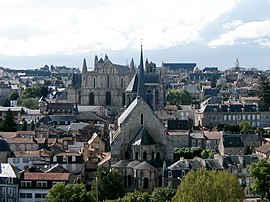Our website is made possible by displaying online advertisements to our visitors.
Please consider supporting us by disabling your ad blocker.
Poitiers
Poitiers
Poetàe (Poitevin–Saintongeais) | |
|---|---|
Prefecture and commune | |
 Historic centre of Poitiers with Church of Saint-Radegund, Cathedral of Saint-Pierre and the Palace of Poitiers in the background | |
| Coordinates: 46°35′N 0°20′E / 46.58°N 0.34°E | |
| Country | France |
| Region | Nouvelle-Aquitaine |
| Department | Vienne |
| Arrondissement | Poitiers |
| Canton | Poitiers-1, 2, 3, 4 and 5 |
| Intercommunality | CU Grand Poitiers |
| Government | |
| • Mayor (2020–2026) | Léonore Moncond'huy[1] (The Greens) |
Area 1 | 42.11 km2 (16.26 sq mi) |
| Population (2022)[2] | 89,472 |
| • Density | 2,100/km2 (5,500/sq mi) |
| Demonym | Poitevin·e |
| Time zone | UTC+01:00 (CET) |
| • Summer (DST) | UTC+02:00 (CEST) |
| INSEE/Postal code | 86194 /86000 |
| Elevation | 65–144 m (213–472 ft) (avg. 75 m or 246 ft) |
| Website | poitiers.fr (in French) |
| 1 French Land Register data, which excludes lakes, ponds, glaciers > 1 km2 (0.386 sq mi or 247 acres) and river estuaries. | |
Poitiers[a] is a city on the river Clain in west-central France. It is a commune, the capital of the Vienne department and the historical centre of Poitou. In 2021, it had a population of 90,240. Its conurbation had 134,397 inhabitants in 2021 and is the centre of an urban area of 281,789 inhabitants. It is a city of art and history, still known as "Ville aux cent clochers" (literal translation: "City of hundred bell towers").
With more than 30,000 students, Poitiers has been a major university city since the creation of its university in 1431, having hosted René Descartes, Joachim du Bellay and François Rabelais, among others. The centre of town is picturesque; its streets include predominantly historical architecture and half-timbered houses,[8] especially religious architecture, mostly from the Romanesque period. The latter includes notably the 4th century baptistery of Saint-Jean (Baptistère Saint-Jean), the hypogeum of the Dunes (7th century), the church of Notre-Dame-la-Grande (12th century), the church of Saint-Porchaire (12th century) or Poitiers Cathedral (end of the 12th century) as well as the Palace of Poitiers, until recently a courthouse (12th century), the former palace of the Counts of Poitou, Dukes of Aquitaine, where the Queen of France and England Eleanor of Aquitaine held her court.
The city's name is associated with two major battles that took place in the area. The first, in 732, also known as the Battle of Tours (to avoid confusion with the second), saw the Franks commanded by Charles Martel defeat an expeditionary army of the Umayyad Caliphate. The second, in 1356, was one of the key battles of the Hundred Years' War. It saw the defeat of a larger French royal army by the English and the capture of John II by the victorious Prince of Wales.
The Poitiers agglomeration, located halfway between Paris and Bordeaux, is home to the Futuroscope technopole, which includes major public (CNED, Canopé, etc.) and private companies of national scope, as well as leading European research laboratories. With two million visitors annually, Futuroscope is the leading tourist site in Nouvelle-Aquitaine, and the third most popular amusement park in France after Disneyland Paris and the Puy du Fou.
- ^ "Répertoire national des élus: les maires" (in French). data.gouv.fr, Plateforme ouverte des données publiques françaises. 8 October 2023.
- ^ "Populations de référence 2022" (in French). The National Institute of Statistics and Economic Studies. 19 December 2024.
- ^ Wells, John C. (2008). Longman Pronunciation Dictionary (3rd ed.). Longman. ISBN 978-1-4058-8118-0.
- ^ Jones, Daniel (2011). Roach, Peter; Setter, Jane; Esling, John (eds.). Cambridge English Pronouncing Dictionary (18th ed.). Cambridge University Press. ISBN 978-0-521-15255-6.
- ^ "Poitiers". The American Heritage Dictionary of the English Language (5th ed.). HarperCollins. Retrieved 3 May 2019.
- ^ "Poitiers" (US) and "Poitiers". Lexico UK English Dictionary. Oxford University Press. Archived from the original on 6 August 2020.
- ^ "Poitiers". Merriam-Webster.com Dictionary. Merriam-Webster. Retrieved 3 May 2019.
- ^ Chisholm, Hugh, ed. (1911). . Encyclopædia Britannica. Vol. 21 (11th ed.). Cambridge University Press. pp. 897–899.
Cite error: There are <ref group=lower-alpha> tags or {{efn}} templates on this page, but the references will not show without a {{reflist|group=lower-alpha}} template or {{notelist}} template (see the help page).
Previous Page Next Page






